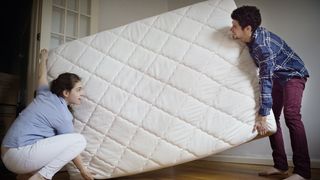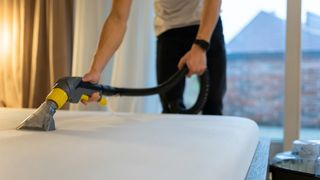How long does a mattress last? Plus, key signs that it’s time to upgrade
Your mattress won't last forever, but how long does it have? Let's check the numbers...

Having a comfortable and supportive mattress is a must, especially when you consider that we spend roughly a third of our lives tucked up in bed. It's safe to say. though, that we might not replace our mattresses as often as we should, and that's a problem because even the best mattresses will wear out eventually.
In general the best memory foam mattresses and best hybrid mattresses will keep going for between seven and 10 years (although some can last a lot longer). But how long a mattress lasts can vary depending on an assortment of factors; there's not only the materials and their quality (latex, for example, tends to be a lot more durable than memory foam), but also things like how you sleep, your weight, and whether you sleep alone or with a partner.
If you're concerned that your mattress may be past its prime, here's where we spell out how long, on average, the different types of mattress should last. We'll also let you know about some warning signs that it's time to replace yours, and to help you ensure that moment doesn't come along for a while, we'll also provide some mattress care tips that can help your bed last longer, such as investing in the best mattress protector you can comfortably afford, and remembering to give your bed a regular clean.
Read on for all the tips you need, but if you already know deep down that it's time to say goodbye to your saggy old bed, maybe you should head straight to our mattress sales guide to find yourself a fresh new mattress at the best price. This is an excellent time of year to buy, as Black Friday typically brings massive discounts and low prices. Check out out Black Friday mattress deals hub for all the best offers on all our favorite mattress brands.
How long does a mattress last: at a glance
There are any number of combinations of materials to be found in the various mattresses on the market, but in general the main types are memory foam, hybrid, latex and innerspring. Each type of mattress has its own likely lifespan; here's a summary of how long you can expect each type to last, on average:
- Latex: 15 to 25 years
- Memory foam: 8-10 years
- Hybrid: 7 to 10 years
- Innerspring: 5 to 7 years
If you’re still sleeping soundly on your bed, but your mattress is over five years old or needs a little boost in terms of comfort or support, consider investing in one of the best mattress toppers. Get the right one and it can give you a few more years of comfortable sleeping on your current bed; see our mattress pad vs mattress topper guide if you're not entirely sure what you should be putting on top of your mattress.
How long does a memory foam mattress last?

Memory foam is pretty durable and you can expect to get around eight to 10 years’ use out from it. This is mainly because there aren’t a lot of materials and components in these mattresses, meaning there’s less to deteriorate and compromise the quality.
Get the best Black Friday deals direct to your inbox, plus news, reviews, and more.
Sign up to be the first to know about unmissable Black Friday deals on top tech, plus get all your favorite TechRadar content.
Memory foam mattresses generally need to be rotated regularly and must be kept clean and aired. If you start waking up with aches and pains and find that the foam is no longer supporting you and offering pressure relief, it’s time to upgrade. During our Saatva Loom & Leaf review, we noted it was particularly good at alleviating aches and pains, and the durable build should support you for many years. But even this premium model will eventually need replacing.
Sink-in body cradling that’s gone from the sublime to the ridiculous is also a red flag. Sink-in cushioning can feel luxurious at first (see our Nectar Memory Foam review to learn more), but with constant use, you can sink so far you feel stuck. Even a firmer build, like the one we noted in our Cocoon by Sealy Chill review, will eventually succumb to sinking. Finally, watch out for the memory foam discoloring (turning yellow) too, as this is a sign of mattress old age.
How long does a latex mattress last?
Latex is the most resilient of all materials listed here, which means that latex mattresses are the longest-lasting. However, this only applies if you buy a 100% natural latex mattress as these can last from 15 to 25 years. Look for the terms organic, Dunlop or Talalay when considering a latex bed. Our best organic mattress guide is a good place to start, or check out our Avocado Green mattress review or Awara Natural Hybrid mattress review to learn more.
Natural latex mattresses often cost more but this is balanced out by the length of time they last for. Blended or synthetic latex has a shorter lifespan of between five to 10 years. It also softens more than natural latex and can produce off-gassing. You can learn more about latex foam, and how it compares to memory foam, with our guide to latex vs memory foam mattresses.
How long does a hybrid mattress last?

Hybrid models aren’t as durable as memory foam, but you can still expect several years of use. Some brands, such as Purple and Casper, state that their hybrid mattresses can last as long as 10 years, due to the high-quality materials they’re made with.
With more layers and components in a hybrid than in most other beds on the market, they can be prone to a little premature sagging, hence the slightly shorter average lifespan.
Hybrids can be rotated regularly but should not be flipped unless the manufacturer specifically states otherwise. This is because they generally have a soft top and a sturdy base. You might also void the warranty if you flip a hybrid mattress when it isn’t designed to be flipped.
We've rated a hybrid mattress – the Saatva Classic – as our number one mattress pick, so we do think these designs can have excellent durability. And as we noted in our Saatva Classic mattress review, it comes with a lifetime warranty.
How long does an innerspring mattress last?
Springs wear down over time and can cause sagging, meaning that innerspring mattresses generally have a lifespan of around five to seven years. But they are extremely popular due to their bounce, comfort and cheaper price tags.
Of course, this can be a false economy as you will end up replacing your mattress more often. If you do want an innerspring bed, it’s worth looking at one with an extra layer of coils combined with a soft pillow top for extra comfort.
Other factors that affect the lifespan of a mattress

Along with the type of mattress you’re sleeping with, there are other factors that will contribute to its lifespan:
Original quality
The quality of your mattress when you originally bought it makes a difference to how long it will last. A very cheap bed is almost certain to wear out before a model made with durable materials. We were impressed with the quality during our Siena Memory Foam mattress review, but even this highly-rated budget buy is likely to wear out quicker than a premium model.
Body weight and sleep position
Those with a heavier body weight may find their mattress sags more quickly. If you’re of a heavier build, it’s worth looking for a mattress made with stronger, durable materials alongside heavy duty springs – our roundup of the best mattresses for heavy people has lots of recommendations.
By the same token, side sleepers put a lot of weight onto the bed in the hip and shoulder regions, causing points in the mattress that sag quicker. Memory foam is the best choice for side sleepers, as they help support and provide pressure relief to the right areas. Take a look at our best mattress for side sleepers to find advice and our top picks.
Frequency of use
This is somewhat obvious, but a mattress that sits in your guest room and is only used occasionally will last longer than the one you sleep on every night.
How to care for your mattress so it lasts longer
Following some simple tips will help extend the lifespan of your mattress, which will save you money in the long-run as you won't need to replace your bed so often:
1. Rotate it regularly to help keep the surface even and prevent any indents. Although some mattresses can be flipped, make sure you check the manufacturer’s guidelines first. Some mattresses are one-sided only and could be damaged if flipped.
2. Put your mattress on a sturdy base. Most manufacturers recommend what type of bed bases suit their mattresses but, as a general guideline, a box spring, platform, or bed frame with evenly spaced slats should provide decent support.

3. Clean and air your bed frequently to keep it fresh. Many modern mattresses have washable covers that can be removed and machine washed, though some can only be spot-cleaned. Run the vacuum over your mattress and wash your bedding regularly to help prevent the build-up of dust mites, bacteria and sweat.
4. Use a mattress protector at all times. These slip over just like a fitted sheet and help to safeguard your bed from dirt, spills, sweat and bacteria. They are easy to machine wash and dry, and they needn't cost much either.
When should you replace your mattress? Key signs
If you don’t know how old your mattress is, there are other ways to tell if it needs replacing. Some classic signs to look for include how:
- You sleep better on any other mattress
- You wake up frequently throughout the night
- You wake up with aches and pains
- Your mattress is turning yellow due to age
- Your mattress has worn patches, tears, or sinks at the edges
- Your mattress feels saggy and unsupportive
- The slightest movement from your partner wakes you up
- You’ve noticed an increase in allergies or asthma symptoms
What you sleep on makes a big difference to how comfortably you sleep, so it pays to get this one right. A good bed needn’t cost the earth though, so don’t fall into the trap of thinking that the most expensive mattress is better than all others.
For some affordable options, check out our guides to the best Saatva mattress sales for hotel luxury for less, or the latest Nectar mattress sales for a top-rated budget memory foam bed-in-a-box.
Read more:
- Mattress protector vs mattress pad: key differences explained
Jo Plumridge is a freelance writer and photographer with over 20 years of experience writing for a variety of magazines, books and websites. She writes, perhaps unsurprisingly, about photography but also extensively on all things sleep and interior design related, alongside home and tech product reviews. She’s lived in the middle of a nature reserve in Botswana and written a guidebook to New Zealand, but now spends a lot of time trying to photograph the cats she and her husband foster for a local charity - without a doubt the most challenging subjects on earth!
Most Popular

